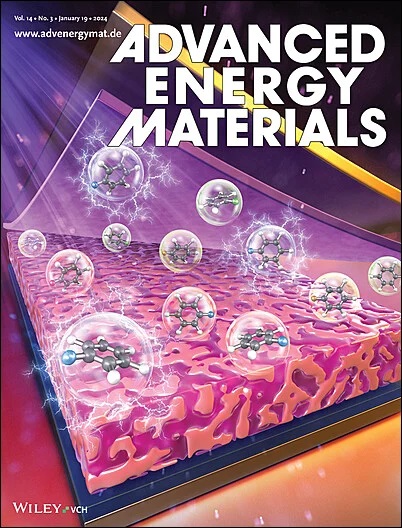物理气相沉积n型PbSe晶体中晶格扁平化导致了高热电冷却性能
IF 24.4
1区 材料科学
Q1 CHEMISTRY, PHYSICAL
引用次数: 0
摘要
热电材料可实现固态冷却,这引起了电子行业的极大关注。目前的热电冷却装置依赖于先进的 Bi2Te3 合金。然而,Te 元素的稀缺性提高了热电设备的价格,限制了其广泛应用。因此,开发高性能、低成本的热电材料是该领域的重点。在这项工作中,通过晶格平原化和物理气相沉积,开发出了一种高性能 n 型 PbSe 晶体。研究发现,添加微量的锡可以补偿固有的铅空位,从而有效改善晶体质量,并显著提高电子迁移率,从 1125 cm2 V-1 s-1 提高到 1550 cm2 V-1 s-1。这使得 PbSe 晶体在室温下的功率因数高达 37 µW cm-1 K-2,从而将这种传统的中温发电热电材料转变为固态制冷材料。基于 7 对硒化铅的模块在室温下实现了 52 K 的温差,在 5 K 的冷却条件下显示出 3.5 的性能系数(COP)。单脚效率测试还验证了该材料在 Th = 773 K 时的转换效率为 4.5%。所有这些结果都证明了物理气相沉积 PbSe 晶体的实际应用价值。本文章由计算机程序翻译,如有差异,请以英文原文为准。

Lattice Plainification Leads to High Thermoelectric Cooling Performance in Physically Vapor-Deposited N-Type PbSe Crystal
Thermoelectric materials enable solid-state cooling, which has drawn significant attention in the electronics industry. Current thermoelectric cooling devices rely on advanced Bi2Te3 alloys. However, the scarcity of the Te element raises the price of thermoelectric devices and limits their widespread use. Therefore, developing high-performance, low-cost thermoelectric materials is a key focus in the field. In this work, a high-performance n-type PbSe crystal is developed through lattice plainification and physical vapor deposition. Adding trace amounts of Sn is found to compensate for intrinsic Pb vacancies, which effectively improves the crystal quality and significantly enhances the electron mobility from 1125 to 1550 cm2 V−1 s−1. This results in a high power factor of 37 µW cm−1 K−2 at room temperature for PbSe crystal, transforming this traditional mid-temperature power generation thermoelectric material into a solid-state refrigeration material. The 7-pairs PbSe-based module achieves a temperature difference of 52 K at room temperature, demonstrating a competitive coefficient of performance (COP) of 3.5 under 5 K cooling conditions. Single-leg efficiency tests also validate a 4.5% conversion efficiency at Th = 773 K for the material. All of these results demonstrate the practical application value of the physically vapor-deposited PbSe crystal.
求助全文
通过发布文献求助,成功后即可免费获取论文全文。
去求助
来源期刊

Advanced Energy Materials
CHEMISTRY, PHYSICAL-ENERGY & FUELS
CiteScore
41.90
自引率
4.00%
发文量
889
审稿时长
1.4 months
期刊介绍:
Established in 2011, Advanced Energy Materials is an international, interdisciplinary, English-language journal that focuses on materials used in energy harvesting, conversion, and storage. It is regarded as a top-quality journal alongside Advanced Materials, Advanced Functional Materials, and Small.
With a 2022 Impact Factor of 27.8, Advanced Energy Materials is considered a prime source for the best energy-related research. The journal covers a wide range of topics in energy-related research, including organic and inorganic photovoltaics, batteries and supercapacitors, fuel cells, hydrogen generation and storage, thermoelectrics, water splitting and photocatalysis, solar fuels and thermosolar power, magnetocalorics, and piezoelectronics.
The readership of Advanced Energy Materials includes materials scientists, chemists, physicists, and engineers in both academia and industry. The journal is indexed in various databases and collections, such as Advanced Technologies & Aerospace Database, FIZ Karlsruhe, INSPEC (IET), Science Citation Index Expanded, Technology Collection, and Web of Science, among others.
 求助内容:
求助内容: 应助结果提醒方式:
应助结果提醒方式:


